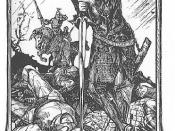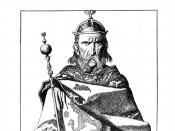Robert de Boron's Merlin portrays Merlin as the prophet of the Holy Grail, a role he was to repeat in the Vulgate cycle. This set of manuscripts fleshes out the role of Merlin as advisor: He tells Uther to establish a knightly fellowship (Round Table, anyone?), and he assures Uther that his true heir will be revealed as the one who could draw the sword from the stone. Finally, Merlin's infatuation with the Lady of the Lake (in most cases Nimue) is introduced.
Merlin, Arthur's adviser, prophet and magician, is basically the creation of Geoffrey of Monmouth, who in his twelfth-century History of the Kings of Britain combined the Welsh traditions about a bard and prophet named Myrddin with the story that the ninth-century chronicler Nennius tells about Ambrosius (that he had no human father and that he prophesied the defeat of the British by the Saxons). Geoffrey gave his character the name Merlinus rather than Merdinus (the normal Latinization of Myrddin) because the latter might have suggested to his Anglo-Norman audience the vulgar word "merde."
In Geoffrey's book, Merlin assists Uther Pendragon and is responsible for transporting the stones of Stonehenge from Ireland, but he is not associated with Arthur. Geoffrey also wrote a book of "Prophecies of Merlin" before his History. The Prophecies were then incorporated into the History as its seventh book. These led to a tradition that is manifested in other medieval works, in eighteenth-century almanac writers who made predictions under such names as Merlinus Anglicus, and in the presentation of Merlin in later literature. Merlin became very popular in the Middle Ages. He is central to a major text of the thirteenth-century French Vulgate cycle, and he figures in a number of other French and English romances. Sir Thomas Malory, in the Morte d'Arthur...


